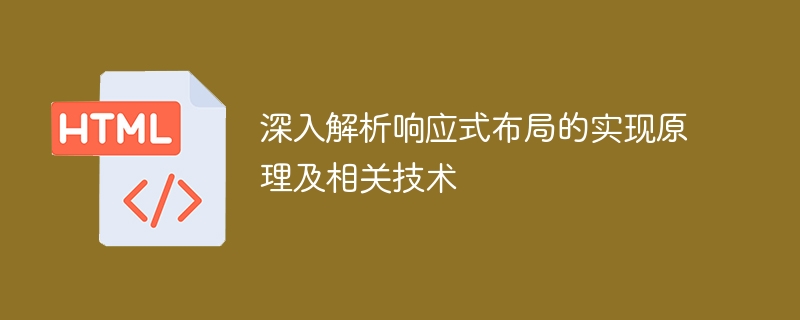

In-depth analysis of the implementation principles and related technologies of responsive layout
In recent years, the popularity of mobile devices and the emergence of multiple screen sizes have led to the adoption of responsive layout in web design Responsive layouts are becoming more and more important. Responsive layout refers to automatically adjusting the layout and style of web pages according to the screen size and characteristics of the device to achieve a better user experience. This article will provide an in-depth analysis of the implementation principles and related technologies of responsive layout, and provide code examples.
Implementation principle:
Media Queries:
Media queries are the basis for implementing responsive layout. By using CSS's @media rules, you can apply different styles for different situations based on screen size, resolution, device orientation, and other conditions. For example:
@media screen and (max-width: 768px) { // 在宽度小于等于768像素时应用的样式 }
The @media rule here specifies a condition when the screen width is less than or equal to 768 pixels, in which styles suitable for small screens can be defined.
Elastic Grid Layout (Flexbox):
Flexible Grid Layout is a flexible grid system that can automatically adjust layout and content based on the size of the container and the size of the content. The position of the element. Flexible grid layout can be enabled by setting the display property of the container todisplay: flex. Responsive layouts can be easily implemented using Flex Grid Layout. For example:
.container { display: flex; }
The .container here is a container. When using elastic grid layout, the sub-elements under it will automatically adjust their position and size.
Fluid Layout:
Fluid layout refers to setting the width of an element according to the percentage of the screen width, so that the element can adapt according to the screen size. Fluid layouts are often used to design web pages that are adapted to mobile devices. For example:
.container { width: 90%; }
Setting the width of the container to 90% can make the container have the same relative width under different screen widths.
Related technologies:
Responsive images:
Under different screen sizes, the size of the image also needs to be adjusted to Avoid going too big or too small. You can use the
Thesrcattribute in the
Mobile-first strategy:
Due to the popularity of mobile devices, responsive layouts often prioritize mobile devices. You can use CSS's@mediarules to set styles for mobile devices, and use themin-widthproperty to adjust the application of styles for different screen widths. For example:
@media screen and (min-width: 768px) { // 在宽度大于等于768像素时应用的样式 }
This ensures that the default style is used on mobile devices and a specific style is used on large screen devices.
Code example:
The following is a simple responsive layout example, which includes the application of media queries, elastic grid layout and fluid layout.
In the above code, the two-column layout is achieved by setting the.rowclass to a flexible grid layout and the width of the.columnclass to 50%. When the screen width is 768 pixels or less, a media query is applied to set the width of.columnto 100%, thus achieving a single-column layout.
Summary:
Responsive layout plays an important role in modern web design. Through technologies such as media queries, elastic grid layout, and fluid layout, the layout and style of web pages can be automatically adjusted according to different screen sizes and device characteristics. At the same time, using responsive images and mobile-first strategies can improve the user experience on different devices. By properly applying these technologies, we can better adapt to a variety of devices and screen sizes.
The above is the detailed content of Explore the implementation principles and related technologies of responsive layout. For more information, please follow other related articles on the PHP Chinese website!




